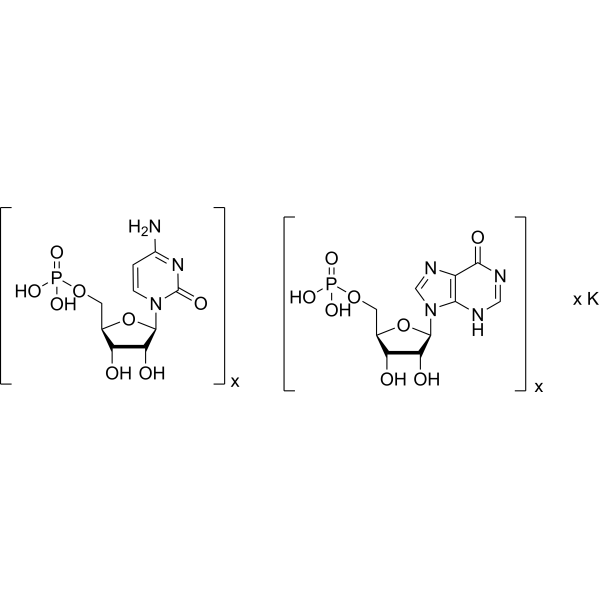Polyinosinic-polycytidylic acid potassium

Polyinosinic-polycytidylic acid potassium structure
|
Common Name | Polyinosinic-polycytidylic acid potassium | ||
|---|---|---|---|---|
| CAS Number | 31852-29-6 | Molecular Weight | 710.5 | |
| Density | N/A | Boiling Point | N/A | |
| Molecular Formula | (C10H13N4O8P)x.(C9H14N3O8P)x.xK | Melting Point | N/A | |
| MSDS | USA | Flash Point | N/A | |
|
The interaction between maternal immune activation and alpha 7 nicotinic acetylcholine receptor in regulating behaviors in the offspring.
Brain. Behav. Immun. 46 , 192-202, (2015) Mutation of human chromosome 15q13.3 increases the risk for autism and schizophrenia. One of the noteworthy genes in 15q13.3 is CHRNA7, which encodes the nicotinic acetylcholine receptor alpha 7 subunit (α7nAChR) associated with schizophrenia in clinical stud... |
|
|
How reliable are sino-nasal cell lines for studying the pathophysiology of chronic rhinosinusitis?
Ann. Otol. Rhinol. Laryngol. 124 , 437-42, (2015) Well-characterized cell lines represent useful scientific tools to study the pathophysiology of human disease. Chronic rhinosinusitis (CRS) is a very common condition, though the number of CRS cell lines is limited, as are data showing how closely they resemb... |
|
|
RIP3-mediated necrotic cell death accelerates systematic inflammation and mortality.
Proc. Natl. Acad. Sci. U. S. A. 112 , 11007-12, (2015) Systematic inflammation contributes to the development of many diseases, including cardiovascular disease, which is the leading cause of mortality worldwide. How such inflammation is initiated and maintained throughout the course of disease remains unclear. I... |
|
|
Toll-like receptors 2 and 3 agonists differentially affect oligodendrocyte survival, differentiation, and myelin membrane formation.
J. Neurosci. Res. 90(2) , 388-98, (2011) Toll-like receptors (TLRs) play a key role in controlling innate immune responses to a wide variety of pathogen-associated molecules as well as endogenous signals. In addition, TLR expression within nonimmune cells has been recognized as as modulator of cell ... |
|
|
Toll-like receptor 3-mediated tumor invasion in head and neck cancer.
Oral Oncol. 48(3 , 226-32, (2011) Chronic inflammation associated with some infectious agents can lead to cancer. The Toll-like receptor (TLR) family is one of the largest and best-studied families of pathogen-associated molecular patterns. TLR3 recognizes double-stranded RNA and is a major e... |
|
|
Nuclear factor κB subunits RelB and cRel negatively regulate Toll-like receptor 3-mediated β-interferon production via induction of transcriptional repressor protein YY1.
J. Biol. Chem. 286(52) , 44750-63, (2011) The induction of β-interferon (IFN-β) is a key anti-viral response to infection by RNA viruses. Virus-induced expression of IFN-β requires the co-operative action of the transcription factors IRF-3/7, NF-κB, and ATF-2/c-Jun on the IFN-β promoter leading to th... |
|
|
Overlapping and distinct roles of GRK5 in TLR2-, and TLR3-induced inflammatory response in vivo.
Cell. Immunol. 272(2) , 107-11, (2011) G-protein coupled receptor kinase-5 (GRK5) is a recently described NFκB regulator in TLR4 signaling pathway. To determine whether the role of GRK5 is MyD88- or TRIF-dependent, we injected wild type and GRK5 knockout mice with Pam3CSK4 (MyD88-dependent TLR1/2 ... |
|
|
Maternal immune activation induces GAD1 and GAD2 promoter remodeling in the offspring prefrontal cortex.
Epigenetics 10 , 1143-55, (2016) Maternal infection during pregnancy increases the risk of neurodevelopmental disorders in the offspring. In addition to its influence on other neuronal systems, this early-life environmental adversity has been shown to negatively affect cortical γ-aminobutyri... |
|
|
Comparative efficacy of virus like particle (VLP) vaccine of foot-and-mouth-disease virus (FMDV) type O adjuvanted with poly I:C or CpG in guinea pigs.
Biologicals 43 , 437-43, (2015) Foot-and-mouth disease (FMD) is one of the most contagious and economically important diseases of cloven-hoofed livestock. Currently used inactivated FMD vaccines have short lived immunity besides risk of handling live virus. We studied recombinant FMD virus ... |
|
|
Activation of chemokine and inflammatory cytokine response in HCV-infected hepatocytes depends on TLR3 sensing of HCV dsRNA intermediates. Li K, Li NL, Wei D, Pfeffer SR, et al.
Hepatology 55(3) , 666-75, (2011)
|